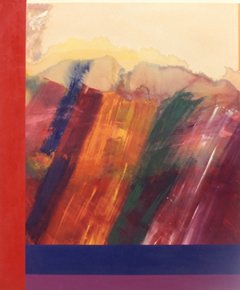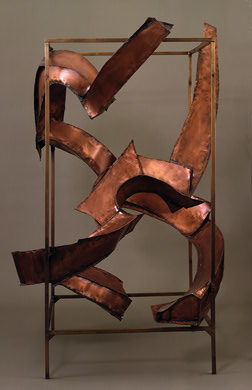Related Research Articles

Mark Rothko, born Markus Yakovlevich Rothkowitz, was a Latvian-born American abstract painter. He is best known for his color field paintings that depicted irregular and painterly rectangular regions of color, which he produced from 1949 to 1970. Although Rothko did not personally subscribe to any one school, he is associated with the American abstract expressionism movement of modern art.

Michael Kelley was an American artist widely considered one of the most influential artists of our time. His work involved found objects, textile banners, drawings, assemblage, collage, performance, photography, sound and video. He also worked on curatorial projects; collaborated with many other artists and musicians; and left a formidable body of critical and creative writing. He often worked collaboratively and had produced projects with artists Paul McCarthy, Tony Oursler, and John Miller. Writing in The New York Times, in 2012, Holland Cotter described the artist as "one of the most influential American artists of the past quarter century and a pungent commentator on American class, popular culture and youthful rebellion."

Sir Michael Craig-Martin is an Irish-born contemporary conceptual artist and painter. He is known for fostering and adopting the Young British Artists, many of whom he taught, and for his conceptual artwork, An Oak Tree. He is an emeritus Professor of Fine Art at Goldsmiths. His memoir and advice for the aspiring artist, On Being An Artist, was published by London-based publisher Art / Books in April 2015.
Alice Aycock is an American sculptor and installation artist. She was an early artist in the land art movement in the 1970s, and has created many large-scale metal sculptures around the world. Aycock's drawings and sculptures of architectural and mechanical fantasies combine logic, imagination, magical thinking and science.

Dominique de Menil was a French-American art collector, philanthropist, founder of the Menil Collection and an heiress to the Schlumberger Limited oil-equipment fortune. She was awarded the National Medal of Arts in 1986.

Ronnie Landfield is an American abstract painter. During his early career from the mid-1960s through the 1970s his paintings were associated with Lyrical Abstraction, and he was represented by the David Whitney Gallery and the André Emmerich Gallery.
Alison Saar is a Los Angeles, California based sculptor, mixed-media, and installation artist. Her artwork focuses on the African diaspora and black female identity and is influenced by African, Caribbean, and Latin American folk art and spirituality. Saar is well known for "transforming found objects to reflect themes of cultural and social identity, history, and religion."
William Roger Welch is an American conceptual artist, installation artist and video artist.

Herbert Ferber was an American Abstract Expressionist, sculptor and painter, and a "driving force of the New York School."
Ming Fay is a Shanghai-born and New York City-based sculptor and professor. His work focuses on the concept of the garden as a symbol of utopia and the relationship between man and nature. Drawing upon an extensive knowledge of plants both Eastern and Western, real and mythical, Fay creates his own calligraphic floating forest of reeds, branches and surreal species. He is most well known for his sculpture and large scale installations and he currently teaches sculpture at William Paterson University in Wayne, New Jersey.

Irving Kriesberg was an American painter, sculptor, educator, author, and filmmaker, whose work combined elements of Abstract Expressionism with representational human, animal, and humanoid forms. Because Kriesberg blended formalist elements with figurative forms he is often considered to be a Figurative Expressionist.

Robert Carleton Hobbs is an American art historian and curator specializing in twentieth-century art. Since 1991 he has held the Rhoda Thalhimer Endowed Chair of American Art in the School of Arts, Virginia Commonwealth University, a highly ranked art department. Since 2004 he has served as a visiting professor at Yale University. He has held positions at Cornell University, University of Iowa, Florida State University, and Tehran Museum of Contemporary Art in Iran, and is known for a number of books, in-depth essays, and exhibitions.

Sharon Louden is an American visual artist, known for her abstract and whimsical use of the line. Her minimalist paintings and drawings have subsequently transformed over the years into other media, being expressed as "drawings-in-space." She has also expanded into a wide-ranging use of color. In reference to her minimalist paintings, Louden has been called "the Robert Ryman of the 21st century."

John de Ménil was a Franco-American businessman, philanthropist, and art patron. He was the founding president of the International Foundation for Art Research (IFAR) in New York. With his wife, Dominique de Menil, he established the Menil Collection, a free museum designed by Renzo Piano and built in 1986 to preserve and exhibit their world-class contemporary art collection.

Sasson Soffer (1925–2009) was an American abstract painter and sculptor. His work has been exhibited extensively throughout the world.

Ree Morton was an American visual artist who was closely associated with the postminimalist and feminist art movements of the 1970s.

Tobi Kahn is an American painter and sculptor. Kahn lives and works in New York City and is on the faculty at the School of Visual Arts.
Jennifer Pastor is an American sculptor and Professor of Visual Arts at the University of California Irvine. Pastor examines issues of space encompassing structure, body and object orientations, imaginary forms, narrative and progressions of sequence.
Michael Somoroff is a conceptual artist, director, and photographer. Somoroff has directed and created work for advertising agencies, publications and cultural institutions. He is also a teacher and cultural commentator who has worked for Stony Brook University, The University of the Arts, The Rothko Chapel and the International Center of Photography.
Craig Kalpakjian is an American artist working in New York, known for his computer-generated, photo-realistic renderings of anonymous, institutional spaces. He is considered one of the first artists of his generation to make digital images depicting entirely artificial spaces in a fine art context.
References
- ↑ Edward A. Shanken, Art and Electronic Media. London: Phaidon Press, forthcoming january 2009. The Themes and Movements series.
- ↑ Wands, Bruce, Art of the Digital Age,
- ↑ Frank Popper, From Technological to Virtual Art, MIT Press
- ↑ Anker, Suzanne and Nelson, Dorothy The Molecular Gaze: Art in the Genetic Age (Cold Spring Harbor Laboratory Press Series on Genomics, Bio- technology)
- ↑ Christiane Paul, Digital Art, Penguin Press.
- ↑ Anne Morgan Spalter, The Computer in the Visual Arts, Addison Wesley Press.
- ↑ Wilson, Stephen, Information Arts: Intersections of Art, Science, and Technology, Wilson is Professor, Conceptual/Information Arts, Art Department, San Francisco State University, MIT Press/Leonard Books.
- ↑ Fifield, George, "Michael Rees, A Diagram of Forces", vol. 23, no. 7 cover story, Sculpture Magazine, September. 2004
- ↑ Ganis, William, "Ars Ex Machina", Sculpture Magazine, vol. 23, no. 7, September 2004.
- ↑ Fifield, George, The Digital Sculptor, Communication Arts.
- ↑ Rinder, Lawrence, catalogue for the BitStreams exhibition, Whitney Museum of American Art, New York, New York. 2001
- ↑ Kertiss, Klauss, Catalogue for The 1995 Whitney Biennial, The Whitney Museum of American Art, New York, New York. 1995
- ↑ Rees, Michael, “Silence and Presence at the Rothko Chapel: An Artist’s Response”, Image of the Not-Seen: Search for Understanding, The Rothko Chapel Art Series, Rothko Chapel, Houston, Texas. (with 3 figures from the Ajna Spine Series) pp. 100-111. 2007
- ↑ Rees, Michael, Yale Sculpture, vol. 26 no. 170 Flash Art, May/June 1993